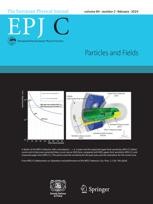Exploring the duality of gravity and gauge theory
This EPJ C Topical Collection presents a series of reviews showcasing the latest developments and applications of gauge/gravity duality, and aims at dissemination to a wider physics community in a way that enables building upon these concepts.
New York | Heidelberg, 15 November 2022
 The gauge/gravity duality states that gravity and quantum spacetime emerges, i.e. can be reconstructed from a quantum gauge theory living at the boundary. Over the past 25 years, this duality, with concrete instances uncovered by string theory, has revolutionised our understanding of systems ranging from black holes, to matter made up of strongly interacting quantum particles featuring intricate webs of entanglement. In this Topical Collection, the journal EPJ C presents a collection of articles reviewing the latest advances in the fundamental understanding of this duality and its groundbreaking applications.
The gauge/gravity duality states that gravity and quantum spacetime emerges, i.e. can be reconstructed from a quantum gauge theory living at the boundary. Over the past 25 years, this duality, with concrete instances uncovered by string theory, has revolutionised our understanding of systems ranging from black holes, to matter made up of strongly interacting quantum particles featuring intricate webs of entanglement. In this Topical Collection, the journal EPJ C presents a collection of articles reviewing the latest advances in the fundamental understanding of this duality and its groundbreaking applications.
Our current understanding of gravity is centred on the relativistic descriptions of spacetime first put forward by Einstein. In parallel, gauge theory describes how the matter fields of elementary quantum particles – including electrons and quarks – interact with each other via forces, mediated by the exchange of gauge bosons – in this case, photons and gluons, respectively. While both theories appear to be governed by completely different sets of rules, the concept of gauge/gravity duality shows how intrinsic links between them are crucial to explaining the fundamental nature of the universe.
The papers in this Topical Collection include topics like principles for reconstruction of Einstein’s description of spacetime from the dual gauge theory, and how they have led to recent breakthroughs in the resolution of information paradoxes of black holes. They also cover how quantum error correction and complexity play fundamental roles in the emergence of gravity, as well as the current experimental advances in quantum simulations of gauge/gravity duality.
Furthermore, the Topical Collection includes papers which apply these concepts to model the behaviour of matter in neutron stars: stellar remnants which haven’t gained enough mass to collapse into black holes; how hydrodynamics emerges from many-body interactions; and also calculating how the strong force affects the properties of the muon.
In doing this, EPJ C hopes to provide a suitable background on these expansive subjects, which can be readily grasped and further developed by physicists working in a wide range of specialised areas, such as gravity, condensed matter physics and quantum information theory.
All articles of this EPJ C Topical Collection are available Open Access here. For further information read the Editorial by Ayan Mukhopadhyay.
Reference: Ayan Mukhopadhyay. New frontiers in holographic duality. Eur. Phys. J. C 82, 877 (2022). https://doi.org/10.1140/epjc/s10052-022-10838-4
Further Information
For more information visit: www.epj.org
Services for Journalists
The full-text article is available open access here.
Contact
Sabine Lehr | Springer | Physics Editorial Department
tel +49-6221-487-8336 | sabine.lehr@springer.com
